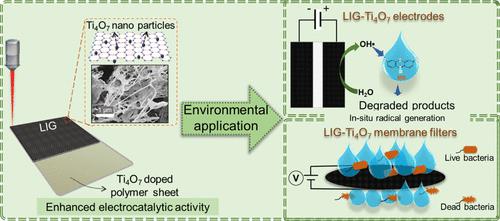当前位置:
X-MOL 学术
›
ACS Appl. Mater. Interfaces
›
论文详情
Our official English website, www.x-mol.net, welcomes your
feedback! (Note: you will need to create a separate account there.)
Magnéli-Phase Ti4O7-Doped Laser-Induced Graphene Surfaces and Filters for Pollutant Degradation and Microorganism Removal
ACS Applied Materials & Interfaces ( IF 8.3 ) Pub Date : 2022-11-09 , DOI: 10.1021/acsami.2c10348 Ashish Kumar 1 , Najmul H Barbhuiya 1 , Kritika Jashrapuria 1 , Nandini Dixit 1 , Christopher J Arnusch 2 , Swatantra P Singh 1, 3, 4
ACS Applied Materials & Interfaces ( IF 8.3 ) Pub Date : 2022-11-09 , DOI: 10.1021/acsami.2c10348 Ashish Kumar 1 , Najmul H Barbhuiya 1 , Kritika Jashrapuria 1 , Nandini Dixit 1 , Christopher J Arnusch 2 , Swatantra P Singh 1, 3, 4
Affiliation

|
Laser-induced graphene (LIG) has recently become a point of attraction globally as an environmentally friendly method to fabricate graphene foam in a single step using a CO2 laser. The electrical properties of LIG are studied in different environmental applications, such as bacterial inactivation, antibiofouling, and pollutant sensing. Furthermore, metal or nonmetal doping of graphene enhances its catalytical performance in pollutant degradation and decontamination. Magnéli phase (TinO2n–1) is a substoichiometric titanium oxide known for its high electrocatalytic behavior and chemical inertness and is being explored as a membrane or electrode material for environmental decontamination. Here, we show the fabrication and characterization of LIG–Magnéli-phase (Ti4O7) titanium suboxide composites as electrodes and filters on poly(ether sulfone). Unlike undoped LIG electrodes, the doped Ti4O7–LIG electrodes exhibit enhanced electrochemical activity, as demonstrated in electrochemical characterization using cyclic voltammetry and electrochemical impedance spectroscopy. Due to the in situ generation of hydroxyl radicals on the surface, the doped electrodes exhibit increase in methylene blue degradation and microorganism removal. Effects of voltage and doping were examined, resulting in a clear trend of degradation and decontamination performance proportional to the doping concentration and applied voltage giving the best result at 2.5 V for 10% Ti4O7 doping. The LIG–Ti4O7 surfaces also showed biofilm inhibition against mixed bacterial culture. The flow-through filtration using a LIG–Ti4O7 conductive filter showed complete bacterial killing with 6 log removal in the permeate at 2.5 V, an enhancement of ∼2.5 log compared to undoped LIG filters at a flow rate of ∼500 L m–2 h–1. The facile fabrication of Ti4O7-doped LIG with enhanced electrochemical properties can be effectively used for energy and environmental applications.
中文翻译:

用于污染物降解和微生物去除的 Magnéli 相 Ti4O7 掺杂激光诱导石墨烯表面和过滤器
激光诱导石墨烯 (LIG) 作为一种使用 CO 2激光一步制造石墨烯泡沫的环保方法,最近已成为全球关注的焦点。LIG 的电气特性在不同的环境应用中进行了研究,例如细菌灭活、抗生物污染和污染物传感。此外,石墨烯的金属或非金属掺杂增强了其在污染物降解和去污方面的催化性能。Magnéli 相 (Ti n O 2 n –1) 是一种亚化学计量的二氧化钛,以其高电催化行为和化学惰性而闻名,正在探索作为环境净化的膜或电极材料。在这里,我们展示了 LIG-Magnéli 相 (Ti 4 O 7 ) 钛低氧化物复合材料的制造和表征,作为聚(醚砜)上的电极和过滤器。与未掺杂的 LIG 电极不同,掺杂的 Ti 4 O 7–LIG 电极表现出增强的电化学活性,如使用循环伏安法和电化学阻抗谱的电化学表征所证明的那样。由于在表面上原位产生羟基自由基,掺杂电极表现出亚甲蓝降解和微生物去除的增加。检查了电压和掺杂的影响,导致与掺杂浓度和施加的电压成正比的明显的退化和去污性能趋势,对于 10% Ti 4 O 7掺杂,在 2.5 V 下给出最佳结果。LIG–Ti 4 O 7表面还显示出对混合细菌培养物的生物膜抑制作用。使用 LIG–Ti 4 O的流通过滤7导电过滤器显示完全杀灭细菌,在 2.5 V 时渗透液中去除了 6 log,与流速为 ~500 L m –2 h –1的未掺杂 LIG 过滤器相比提高了 ~2.5 log 。具有增强电化学性能的 Ti 4 O 7掺杂 LIG 的简便制造可有效用于能源和环境应用。
更新日期:2022-11-09
中文翻译:

用于污染物降解和微生物去除的 Magnéli 相 Ti4O7 掺杂激光诱导石墨烯表面和过滤器
激光诱导石墨烯 (LIG) 作为一种使用 CO 2激光一步制造石墨烯泡沫的环保方法,最近已成为全球关注的焦点。LIG 的电气特性在不同的环境应用中进行了研究,例如细菌灭活、抗生物污染和污染物传感。此外,石墨烯的金属或非金属掺杂增强了其在污染物降解和去污方面的催化性能。Magnéli 相 (Ti n O 2 n –1) 是一种亚化学计量的二氧化钛,以其高电催化行为和化学惰性而闻名,正在探索作为环境净化的膜或电极材料。在这里,我们展示了 LIG-Magnéli 相 (Ti 4 O 7 ) 钛低氧化物复合材料的制造和表征,作为聚(醚砜)上的电极和过滤器。与未掺杂的 LIG 电极不同,掺杂的 Ti 4 O 7–LIG 电极表现出增强的电化学活性,如使用循环伏安法和电化学阻抗谱的电化学表征所证明的那样。由于在表面上原位产生羟基自由基,掺杂电极表现出亚甲蓝降解和微生物去除的增加。检查了电压和掺杂的影响,导致与掺杂浓度和施加的电压成正比的明显的退化和去污性能趋势,对于 10% Ti 4 O 7掺杂,在 2.5 V 下给出最佳结果。LIG–Ti 4 O 7表面还显示出对混合细菌培养物的生物膜抑制作用。使用 LIG–Ti 4 O的流通过滤7导电过滤器显示完全杀灭细菌,在 2.5 V 时渗透液中去除了 6 log,与流速为 ~500 L m –2 h –1的未掺杂 LIG 过滤器相比提高了 ~2.5 log 。具有增强电化学性能的 Ti 4 O 7掺杂 LIG 的简便制造可有效用于能源和环境应用。

































 京公网安备 11010802027423号
京公网安备 11010802027423号